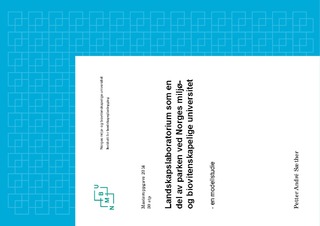| dc.contributor.author | Sæther, Petter André | |
| dc.date.accessioned | 2015-12-18T12:53:33Z | |
| dc.date.available | 2015-12-18T12:53:33Z | |
| dc.date.issued | 2014-12-18 | |
| dc.identifier.uri | http://hdl.handle.net/11250/2368508 | |
| dc.description.abstract | Det er ikke mulig å flytte et landskap inn i et laboratorium for å forske på det, men laboratoriet, og laboratorietankegangen, kan overføres til landskapet. Dette er bakgrunnen for konseptet landskapslaboratorium, der hensikten er å skape et fullskala utendørsmiljø til tverrfaglig forskning, utprøving, eksperimentering, undervisning og formidling.
I forbindelse med flyttingen av Norges veterinærhøgskole og Veterinærinstituttet fra Oslo til Ås, vil det skje en utvidelse av parken ved NMBU. Utvidelsen gir en unik mulighet til å tenke nytt om hvordan uteområdet ved universitetet skal brukes. Denne masteroppgaven ser nærmere på hvordan et landskapslaboratorium kan legges til det nye uteområdet, og hvordan det kan utformes og integreres som en del av campus-området ved NMBU. Oppgaven ser også på hvilke temaer som er aktuelle for et slikt laboratorium, og går nærmere inn på tre av disse. Oppgaven er utført som en modellstudie, der vegetasjonsvolumer og vegetasjonsuttrykk er prøvd ut i en fysisk modell.
Oppgaven er delt inn i 6 deler. Del 1 gir en innledning til oppgaven, og presenterer bakgrunn, problemstilling og metode. Del 2 går nærmere inn på NMBU-parkens historie og gir en kort introduksjon til landskapslaboratoriet i Alnarp. Denne delen fungerer som kunnskapsgrunnlag for oppgaven. Analysedelen, del 3, tar for seg utbyggingsområdet med NMBU-parken og omkringliggende landskap. Ut fra analysematerialet kommer oppgaven frem til ulike temaer for landskapslaboratoriet, der oppgaven går videre med tre tema; energiskog, lokal overvannsdisponering og vannrensing ved hjelp av vegetasjon. Prinsippene for disse tre temaene presenteres, sammen med konseptene, i del 4. Modellstudiene vises i del 5. I modellstudiene er det undersøkt hvor det kan være åpent, og hvor det kan tettes igjen. Det er i tillegg sett på hvilke strukturer og elementer i det omkringliggende landskapet som kan trekkes inn i laboratoriet. Modellstudiene ender opp i et løsningsforslag, som diskuteres i del 6. | nb_NO |
| dc.description.abstract | The landscape cannot be moved to a laboratory for study. Rather the laboratory, and the laboratory thinking, needs to be transferred to the landscape. This is the background for the concept of a landscape laboratory, where the purpose is to create a full-scale outdoor environment for interdisciplinary research, testing, experimentation and education.
When The Norwegian School of Veterinary Science and The Norwegian Veterinary Institute move from Oslo to Ås, the park at the NMBU will be expanded. The expansion provides a unique opportunity to rethink how the outdoor area at the University shall be used. This thesis examines how a landscape laboratory can be part of the outdoor area, and how it can be designed and integrated as part of the campus area at the NMBU. The thesis also examines which topics may be appropriate for a landscape laboratory, and goes into detail on three of these. The thesis is done as a model study, where volumes of vegetation and the expressions of vegetation are examined in a physical model.
This thesis is divided into six parts. Part 1 provides an introduction to the thesis, and presents the background, the issue addressed and the method. Part 2 examines the history of the park at the NMBU, and gives a brief introduction to the landscape laboratory in Alnarp. This details in this section provides the theoretical basis for the thesis. Part 3 gives an analysis of the developing area, included the park at the NMBU and the surrounding area. Based on these analyses, the thesis gives different themes for the landscape laboratory, where three topics are examined further: energy forest, storm water disposal and water purification by using plants. These three themes are presented further in Part 4, which also shows the concepts. The model studies are presented in Part 5. The model studies were used to examine which areas could be open spaces, and which areas could be filled with vegetation. Also examined are structures and elements from the surrounding areas which could be part of the landscape laboratory. The proposed solutions, based on the model studies, are discussed in Part 6. | nb_NO |
| dc.language.iso | nob | nb_NO |
| dc.publisher | Norwegian University of Life Sciences, Ås | |
| dc.title | Landskapslaboratorium som en del av parken ved Norges miljø- og biovitenskapelige universitet - en modellstudie | nb_NO |
| dc.title.alternative | Landscape Laboratory as Part of the Park at the Norwegian University of Life Sciences - a Model Study | nb_NO |
| dc.type | Master thesis | nb_NO |
| dc.subject.nsi | VDP::Social science: 200::Urbanism and physical planning: 230::Landscape planning: 236 | nb_NO |
| dc.source.pagenumber | 84 | nb_NO |
| dc.description.localcode | M-LA | nb_NO |
